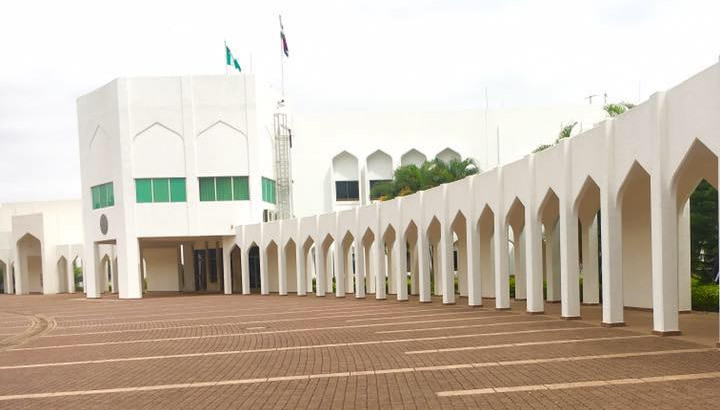
Buhari’s successor to determine furniture as SGF panel handles renovation
Ahead of the swearing-in of the President-elect, Bola Tinubu on May 29, the State House Management has begun renovating and refurbishing sections of the Presidential Villa, Abuja.
Saturday PUNCH observed on Friday that the concrete perimeter fence encompassing the President’s office, official residence, the Council Chamber, press gallery, as well as other administrative offices were being overlaid with new white and green paints.
One of our correspondents observed on Thursday the delivery of new furniture to the green room adjoining the Council Chamber.
Months earlier, the management had carried out a routine upgrade of card readers and installed barricades in areas, which were once freeways.
A senior State House official, who spoke to Saturday PUNCH on condition of anonymity, said the maintenance was part of the tasks carried out by the Presidential Transition Council chaired by the Secretary to the Government of the Federation, Boss Mustapha.
On February 14, 2023, the Federal Government inaugurated the 22-member Presidential Transition Council ahead of the handover to the incoming government.
The committee comprises Cabinet Affairs, General Service Affairs, Economic and Political Affairs, Office of the SGF and State House permanent secretaries, as well as the National Security Adviser, among others.
In April, the President-elect nominated 14 more persons to join the transition council.
The official said, “The changes and upgrades we are doing are part of broader maintenance works. Some are routine, while others, like the painting, are done when the Villa is to host a new occupant.
“These follow the directives of the transition committee, which the SGF is in charge of. The card readers have since been changed. Those are just routine maintenance done when the old ones have passed their active life.
“Repainting is required because, over the years, the State House wildlife accommodates monkeys that roam free and stain these white walls. The bats we have here also deposit their droppings on the walls.”
Asked for the total amount earmarked for the works, the official said, “We don’t go outside the budget allocated to the State House, but the transition committee is shouldering any special cost.”
Since 2016, N3.05bn has been earmarked for “maintenance services” at the State House. These include maintenance of office furniture, office buildings and residential quarters, among others.
The Senior Special Assistant to the President on Media and Publicity, Garba Shehu, who took to his Twitter page on Friday, posted a photo where a man was seen painting the external wall of the Villa with white and green paints.
He noted that the painting was being done in order to welcome the incoming President.
Shehu wrote under the picture, “Painter at work. Villa wearing a new look for the incoming President.”
In June 2015, Buhari finally moved into the Aso Rock Presidential Villa, Abuja, almost three weeks after his inauguration.
He could not move into his official residence immediately after inauguration because renovation works were still going on at the Villa.
Before moving into Aso Rock, Buhari had shuttled between the Defence House in Maitama and his personal residence in the Asokoro district.
In August 2017, Buhari, who resumed duties after a 103-day medical vacation abroad, operated from his official residence until the completion of the renovation of his office.
Shehu, had said the President’s office needed renovation because of its devastation by rodents during Buhari’s long period of absence, adding that rodents had caused a lot of damage to the furniture and air conditioning units.
His predecessor, Dr Goodluck Jonathan, had in May 2015 relocated to the Glass House in the sprawling Aso Presidential Villa to allow for its renovation prior to Buhari’s swearing in.
Shortly after the announcement of that year’s presidential election result, Jonathan and his wife, Patience, had moved their personal belongings out of the official residence to their Otuoke, Bayelsa State residence.
Just like his predecessors, Tinubu is expected to have input in the furniture that will be installed in his official residence and office as well as the paint colours, which will be done to his taste, but the minor repairs will be done on some parts of the house, while cleaning and repainting of the entire residence with white paint will be done.
In the 2023 Appropriation Act, a total of N148,168,464,339 was allocated for the Presidency. Out of this, N14,808,479,660 was allocated to the State House headquarters, a sum of N3,441,177,028 was budgeted for State House operation of the President, while N1,555, 447, 054 was allocated on the State House operations for the Vice-President.
A total of N10,108,606,550 was budgeted for projects in the State House headquarters from which a sum of N19, 382, 375 was allocated for the purchase of sporting equipment for the State House Sports Club, while N14, 773, 412 was budgeted for procurement of equipment for the central gymnasium renovation.
For the renovation works on eight blocks of 16 two-bedroom flats at the State House security quarters, N 132,303,624 was set aside, while N87,255,745 was budgeted for the provision of the Electronic Document Management System.
A sum of N150,000,000 was also set aside for the replacement of telecommunications infrastructure at the villa; N25,023,505 for the upgrade of the State House library, and N7,562,000 for digital medical references for the library.
Rehabilitation of animal enclosure/procurement of vet lab equipment took N35,251,776, while the sum of N130,076,825 was allocated for the conversion/upgrade of the villa ranch and construction of wildlife conservation capture.
A total of N16,077,800 was approved for the purchase of plant nursery equipment for the production of local flowers for routine floral arrangement, irrigation and upgrade of helipad grass field, and N35,725,000 for systemic collection and assessment of data about projects and programmes to aid the management to make decisions. But a sum of N1,904,388,461 was also budgeted for the phased replacement of vehicles and spares during the year.
On annual routine maintenance of mechanical/ electrical installations of the villa, a sum of N7,200,045,297 was budgeted to be spent, and N99,656,180 on the purchase of various office equipment for the admin, finance and accounts, works, ICT, procurement, PRS and audit departments.
A sum of N251,084,550 was also budgeted for the purchase of tyres for bulletproof vehicles, plain cars, CCU vehicles, platforms trucks, SUVs, ambulances and other utility and operational vehicles.
The Presidency had proposed N5.23bn for the general rehabilitation and repair of fixed assets in the Aso Rock Presidential Villa in the 2022 Appropriation Bill.
A total of N5,176,045,297 was budgeted for the rehabilitation/repair of office buildings, while N55,056,446 was earmarked for residential buildings.
In the 2021 proposal, N4,854,381,299 was set aside for the annual routine maintenance of mechanical/electrical installations in the Villa.
The construction of the presidential wing in the State House Medical Centre was expected to gulp N21,974,763,310.
Following the creation of the Federal Capital Territory in 1976, the Akinola Aguda House (formally christened on October 1, 1983) was originally conceived as a presidential lodge and guesthouse complex – comprising a temporary official residence for the President as well as guesthouses for visiting Heads of State – during the presidency of Alhaji Shehu Shagari, according to information on the State House website.
In October 1982 the Aguda House hosted the first ever formal cabinet meeting held outside Lagos, only days after Abuja hosted Nigeria’s Independence anniversary celebration for the first time.
In 1985, the construction of a new presidential residence commenced and in 1991, the Aso Rock Presidential Villa was completed and former military dictator, General Ibrahim Babangida, became the first Head of State to occupy it, moving in on December 12, 1991.
Upon completion of the Aso Rock Presidential Villa the Aguda House became the Vice-Presidential Complex, and has remained so till date — apart from the period between 1999 and 2007 when the Vice-President lived in a residence that was later transferred to the judiciary as official quarters for the Chief Justice of Nigeria.
In 2010, construction of a new vice-presidential residence commenced. The residence has yet to be completed; the Buhari administration has said it is not a priority, and that Vice-President Osinbajo will continue to live in Aguda House.
Today, the Presidential Complex, located in the Three Arms Zone of the Federal Capital Territory, consists of the main presidential villa (office and residence of the President, and offices of the Vice-President and wife of the President), the State House Conference Centre, State House annexe, and the Akinola Aguda House.
Tinubu’s camp reacts
A source in the camp of the President-elect told one of our correspondents that it was the prerogative of Tinubu to decide how he wants the renovation.
He, however, could not confirm if Tinubu was already making input into the renovation.
The source stated, “That should be the duty of the permanent secretary in the State House. I have no knowledge if the renovation has started or if the President-elect is being carried along to ensure it meets his taste.
“But by and large, the new President will determine what he wants in place. They won’t change anything for him without his knowledge. That also depends on what he wants.”




